Home Tycoon Potential, Part Three: Urban Exploitation
By Gideon, HSM team writer
Well, here it is. The beginning of unfounded idea pitching toward Home Tycoon in the hopes that one or two of the concepts folds into the still doughy surface of this upcoming possible game changer… perhaps “possible Home changer” is more accurate. Either way, this article will continue to explore the possibilities of Home Tycoon, just as the previous articles have done. Haven’t read those yet? Well fear not intrepid reader, you can find the intro to the Home Tycoon Potential series HERE and the speculation of possible vehicular interaction methods HERE.
This third installment of the series departs from the announced features of Home Tycoon and builds upon the core concepts of the program to propose elements that would make for a more substantial city building and managing experience. All concepts featured in this article will focus on gameplay elements that involve the structures of the city. Since not too much is known about the dynamic of city building and how players might be able to interact with cities, when on foot or in mayoral mode, there will be a fair amount of creative liberty taken with some of the suggestions. This doesn’t mean, however, that the core of Home Tycoon game play will be disregarded.
All suggestions will still take into account what is currently known and assumed about Home Tycoon. Primarily, the structures within Home Tycoon will not be accessible to players as a three dimensional navigable space. Players will not be able to enter the buildings and the mini-games imagined in this article will not suggest that “enterable buildings” be a feature incorporated into Home Tycoon. This doesn’t mean, however, there won’t be a fair amount of fanciful speculation as to what sort of features and interactivity the buildings of Home Tycoon might be capable of. Exactly what kind of speculation are we talking about? Read on to find out!
Like a Mayor
Home Tycoon should be, first and foremost, a city building game. The primary function of the player when in their own Home Tycoon space should be acting as the Mayor. All other functionality of the game should be secondary. The secondary features, such as vehicular gameplay, should be incorporated in a way that builds, sustains, and promotes the growth of the city. Every mini-game played should have an impact on the wellbeing or productivity of the city as a whole. This means the city needs metrics.
As far we can tell, the metrics of Home Tycoon includes population, work productivity, coinage and an overall citizen satisfaction. In order for Home Tycoon to be as comprehensive as it can be in its city building simulation, it could include a plethora of other metrics by which city success is rated. These metrics could include, but not be limited to, energy (electricity), utilities (water, sewage, garbage, gas), resources (coal, oil, trees, raw minerals of varying types) production (concrete, iron, brick), environmental (pollution), economical (profits and debt), and sociological (crime, health and poverty). All these statistics could play off one another and would not have to be directly controlled by the Mayor, but should be directly viewable. By having a multitude of metrics that have an active influence on the city Home Tycoon can achieve a grander strategic element instead of being little more than a personal space in which you can place buildings.
Hopefully economics will play a large role in the success of a Home Tycoon city. Balancing the tax rates with population and business success could be an invaluable tool in establishing Home Tycoon as a city building simulation. It could even come to pass that at some point, Home Tycoon allows a Mayor to purchase shares in businesses that have come to their city. The success of the business could yield in-game coinage (let’s call them Tycoon Tokens) to the Mayor and could serve as a rudimentary stock market mini-game within the city. The success rate of businesses could have an effect on the economic health of the city and would be directly related to the happiness of the citizens. If a Mayor made the choice to never invest in any businesses within their city, then the stock market statistics would not have a directly visible effect on their city.
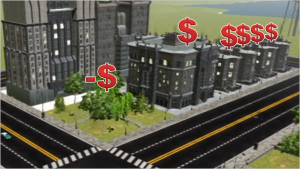
Each structure should have an impact on the city, regardless of whether that impact be a positive or negative one.
Most of these proposed statistics would have a cumulative effect on the overall happiness of the citizenry, which would allow the micromanagement of Home Tycoon societies. This would be yet another aspect of the mini-game of Home Tycoon city building. Certain advanced statistics could have an opt-out function so a Mayor who wishes to simply place buildings and leave them be could do just that. This would allow users not interested in complex city simulations to enjoy a shallower Home Tycoon Experience that may be closer to their liking. The basic free version of Home Tycoon might only support the base metrics that would not have to include advanced statistics such as resources and production.
By giving Mayors the ability to build a sustainable city without ever delving any deeper into the metric capability of Home Tycoon, a broader customer base could be reached. However, if a Mayor were so inclined, they could employ advanced economic practices and purchase resource gathering structures that would enable them to produce even grander buildings within their city to create a more dynamic cityscape.
It’s only a model…
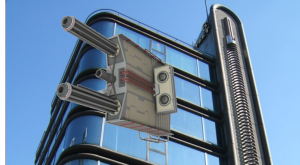
I doubt Home Tycoon will feature Nouvus Prime style upgrades. On second thought… a building with defense cannons might come in handy!
For an example of the concept of structure progression, let’s examine a hypothetical building in the business district of a Home Tycoon City. At the basest of levels (read: Free) a business structure could be a one story building that could house up to 20 employees that would only require Tycoon Tokens and the right zoning to build. This building type could include a robust structure that could hold up to 50 employees and would require a store purchase of the advanced series of plans for this structure type, Tycoon Tokens and zoning to build. The next level, a multiple story building housing 100 employees, would require a more substantial structure, so this level would require Tycoon Tokens, proper zoning, and lumber. The lumber could be obtained from the Lumber Yard, another structure series that would have to be purchased from the Home Tycoon store. The most advanced building available for the business district could be a skyscraper that would of course require Tycoon Tokens and zoning as well as lumber, concrete, iron, glass, a technology level of 4 and could hold up to 10,000 employees. This structure might consume the surface area of nine of the free business buildings but could house 20X the number of employees, which would be an obvious advantage to a quickly growing Home Tycoon city.
This sort of step progression would allow players to chose just how advanced they wish their city, and their Home Tycoon experience, to be. This gameplay element would also serve as an in-game tutorial that would ease gamers into the more advanced elements of Home Tycoon city building. Using this method of content segmentation, more advanced features could be added to Home Tycoon at a later date that builds upon the foundation of the free Home Tycoon model.
When the more advanced production structures, such as a lumber yard, are purchased and placed within a city, the appropriate metric could appear on the Mayor’s statistics and would begin to have an effect on the outcome of the city. Owning a lumber yard would not be required to successfully build a Home Tycoon city, only to build specific and more advanced structures.
Each advanced building series purchased in the store would allow the player to build a number of buildings, the first of which requires the same type of resources as the free structures (Tycoon Tokens and zoning). To build more advanced building types, players would have to purchase specific structures to cultivate specific resources. Structures requiring concrete wouldn’t be able to be placed until the Mayor places a concrete yard in the city and produces a sufficient quantity of concrete. In this way, every purchased building within Home Tycoon can be accessible without the purchase of additional structures. If this were not the case there would be risk of a user purchasing a building only to discover that in order to use their recent purchase they would need to purchase an ironworking facility also. If this situation were allowed to occur, Home Tycoon would without a doubt come under fire from critics and fans alike.
Just like an onion. (They have layers)
Once structures are placed within each Home Tycoon city it would be advantageous if each building had a multifaceted impact on its host city. Each building within Home Tycoon could offer the Mayor interactivity on multiple levels and could affect multiple metrics with just one structure. A Housing complex could do more than simply increase the population capacity; it could be a living, breathing, interactive part of a city. To explore this concept, let’s use the example structure of a Taxi Depot to better understand the ways a singular building could impact a virtual city.
When a Mayor first gathers the appropriate resources to build the Taxi Depot they could gain access to a number of features exclusive to the structure. During construction a building mini-game could be available to assist with the in progress building. If a building takes 5 minutes to complete, playing the construction mini-game could shave a couple of seconds off and doing well could significantly increase the construction productivity. The player would be rewarded with Tycoon Tokens and the overall growth rate of the city would get a boost which could in turn be a factor in how many citizens are attracted to the city. All buildings could include construction mini-games during their construction phase. Having such a feature would encourage city growth and foster feelings of ownership and accomplishment for the Mayor.
Once the Taxi Depot is built, a multitude of features could be unlocked. Taxis could be available to drive around the city (which would include a mini-game all their own) a Dispatch mini-game could be available from the Taxi Depot’s menu. The existence of the Depot would decrease the traffic metric, which could further be lowered by playing the mini-games which were unlocked. The less traffic within a community the higher the overall happiness metric would rise.
Will we be able to grow to be able to build fantastic buildings such as Regatta’s “The Icon” in Jakarta, Indonesia? Hopefully we will find out soon!
While some structure series may allow the Mayor to build more complex and beneficial buildings, utility structures such as the Taxi Depot could work slightly differently. The Taxi depot could grow over time, depending on its success. A Taxi Depot might be able to be upgraded to a more capable company if the appropriate resources are available. If a city can bring their traffic efficiency level up to 60% while maintaining a happiness above 40% the Mayor could have the option of upgrading the car selection within the Depot to include town cars, which would yield more effective and profitable results for the city. Do well enough and the depot might be able to offer limos at some point.
This multi-tier approach to city growth will keep the game fresh and inviting. The complexity of the mini-games wouldn’t be an issue since each mini-game could be designed to be played quickly with just a few moments taken. Their two-dimensional interfaces wouldn’t rely on resource intensive polygonal structures and wouldn’t have to even have multiple levels to be enticing to players. As fun and beneficial as a bank could be in Home Tycoon, not all structures within Home Tycoon have to be an economic boon.
Little Shop of Awesome!
Alongside structures such as office buildings, apartment buildings, police stations, fire stations, prisons, municipal buildings, water treatment facilities and any other number of vanilla buildings, Home Tycoon should offer a wide variety of whimsical structures to help liven each city. These buildings might not follow the same progressive growth model as the other buildings within Home Tycoon. Instead they could offer tourist attraction type excitement for the citizens and player visitors of the city.
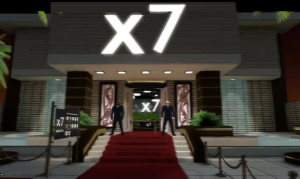
Just IMAGINE how awesome it would be to have an X7 building for your Home Tycoon city! … No I don’t think we will be allowed to purposefully torch the buildings in our own city. Why do you ask?
The mini-games within these attractions would not have to be any more complex than the flash-type mini-games suggested in the preceding section. A fun house could offer a photo booth with an assortment image distortions that could be saved to your hard drive. A Hunted house could offer a jump-scare or two similar to the Mysterious Doll interactive item. A labyrinth structure could simply offer a two-dimensional labyrinth to navigate as quickly as possible. There are no limitations to the variety of attractions that could be offered. Using this method, cities could become custom-built midways that could reward players not with items but with Tycoon Tokens. The city in which the attractions are housed could receive a small Tycoon Token boost as well as a happiness kick for their citizens.
Another building concept could offer direct interactivity with PlayStation Home itself. If the stores that are within the mall were offered as individual structures within Home Tycoon there would be an increased presence of the shopping dynamic of Home and Mayors could enjoy a bit of tax revenue from the stores in the form of Tycoon Tokens. These stores would simply be a portal to the stores themselves and would function very much like the storefronts in the mall. Each time a purchase is completed through one of these stores, no matter the size of the purchase; a few tokens are added to the coffers of the host city. This concept could be expanded to include spaces within Home itself. Placing an Adventure District structure could offer transport to that district and a small token boost for the owner of the structure.
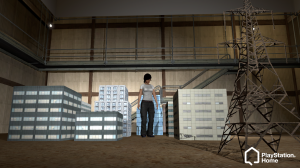
Hopefully Home Tycoon buildings will be able to do much more than these strictly ornamental buildings currently available in PlayStation Home!
The inclusion of any part of these suggestions, however outrageous some might be, could go a long way toward making Home Tycoon a more dynamic experience than building-arrangement. The building specific mini-games would help keep each city bubbling with activity. None of the games would have to be terribly complex. Singular level experiences offering a twenty second sessions could be just enough to give Home Tycoon players a break from city building and car racing. The lack of internally accessible buildings shouldn’t keep each building from being a vital, productive and dynamic adornment on each cities landscape.
So after that long bout of speculation have you, as an eventual user of Home Tycoon, come up with any ideas of your own? What sort of interactivity or structures do you hope to see within the cities of Home Tycoon? This is the time to cut loose and let your imagination fly. Hellfire Games have yet to release any concrete information about the city-building and playing aspect of Home Tycoon, so pretty much any conjecture is fair game.
With the possibilities set forth by vehicular mini-games and structure based interactivity, Home Tycoon is looking to have the possibility of being a force to be reckoned with. Of course. there is more to come in the next part of Home Tycoon Potential where friend interaction and involvement is tackled, wrestled to submission and then awkwardly tickled.


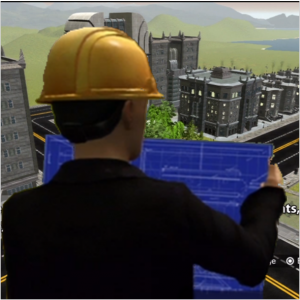
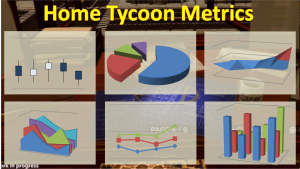
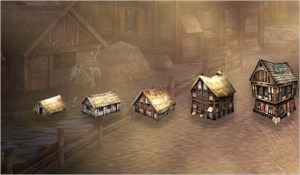
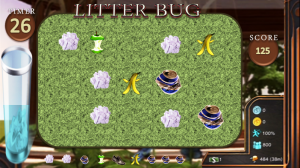
I have never really played these kinds of games much. I got involved with an online medieval town building thing once called Evony where you had to build farms, stone works, stables, and lumber mills to build you town up. You had to have soldiers too and feed them and raise horses to attack other cities and defend against them. You could form alliances with others as well.
This sounds like it could be fun though, might have to check it out. I like your suggestions.
Great article!You got me thinking about grid maps,which I googled and got a short history lesson on Thomas Jefferson!…gotta love Home.I wouldn’t mind seeing a circular map type,something like a wheel with a central hub/marketplace with spokes leading to areas of industry,agriculture,residential areas ect…round buildings would be cool too.